Day 3 of a three day Late Spring Tour today, our last day today. It was a nice sunny day today, still with a chill to the much lighter wind, but lovely and warm out of it. With the wind having swung to the north-east we were hopeful of some migrants today, and so it proved.
News had filtered through about a Greenish Warbler singing at Titchwell, so we headed straight over there first thing to see if we could see it. When we arrived, we could see a few people on the path between the car park and the Visitor Centre and as we approached them we could hear the Greenish Warbler singing in the sallows. It sounded a little bit like a cross between a Willow Warbler, a Chiffchaff and a Wren!
The Greenish Warbler was deep in the trees. We made our way round to the boardwalk on the other side, to see if we could get a look at it from there. A couple of people were already here too and they could see it perched in a patch of sunlight, half hidden in the sallows. It was hard to see, until it started flitting round. Then something chased it and it flew across the boardwalk. We could hear it singing again some way over towards the main path.
Some of group had not managed to see it before it was chased off, so we headed round to the main path. We could hear the Greenish Warbler singing again, but it was round on the other side of willows from here, where the trees were sheltered from wind and catching the morning sun. We followed the song for a while and could tell the bird was flitting around in the trees, before catching glimpses of it moving about. Eventually it came up to a gap between two willows and flicked up into view. Everyone got a good look at it now.

The Greenish Warbler was a small warbler, green-ish above, pale below, rather like a Willow Warbler or a Chiffchaff but with a much more obvious pale supercilium. The wing bar was hard to see but just visible occasionally as it caught the light. It started calling too – a bit like a high pitched sneeze! The song and call sounded very different from the other regular warblers we get here.
Having all enjoyed some good views of the Greenish Warbler, we made our way out onto the reserve to have another look. Even though we had been here a couple of days ago, there was more to see! It was rather breezy as we got out of the trees, but nowhere near as bad as the other day!
A Marsh Harrier was up over the back of the Thornham grazing marsh. Several Reed Warblers flitted back and forth around the edges of the pools below bank. We heard a Bearded Tit calling once or twice, but they were keeping well tucked down. A smart drake Red-crested Pochard was swimming out on the reedbed pool.
Stopping in Island Hide to get out of the wind, we quickly found the drake Garganey first. It was swimming around out in middle, and even though we were looking into the sun we could see its broad white supercilium. It hadn’t been around when we were here on Tuesday so this was a welcome addition to the list and a nice bird to catch up with.

There was still one Little Gull we could see from here, but it was asleep on one of the islands over towards Parrinder Hide. We got it in the scope and could see it was a first summer, probably one of the birds we had seen here the other day.
As we got into the hide, a noisy group of Avocets was arguing, six of them flying round and chasing each other, squabbling. There were not many other waders visible from here today – just a single Redshank, which was a little disappointing given that waders were moving along the coast in the past few days.
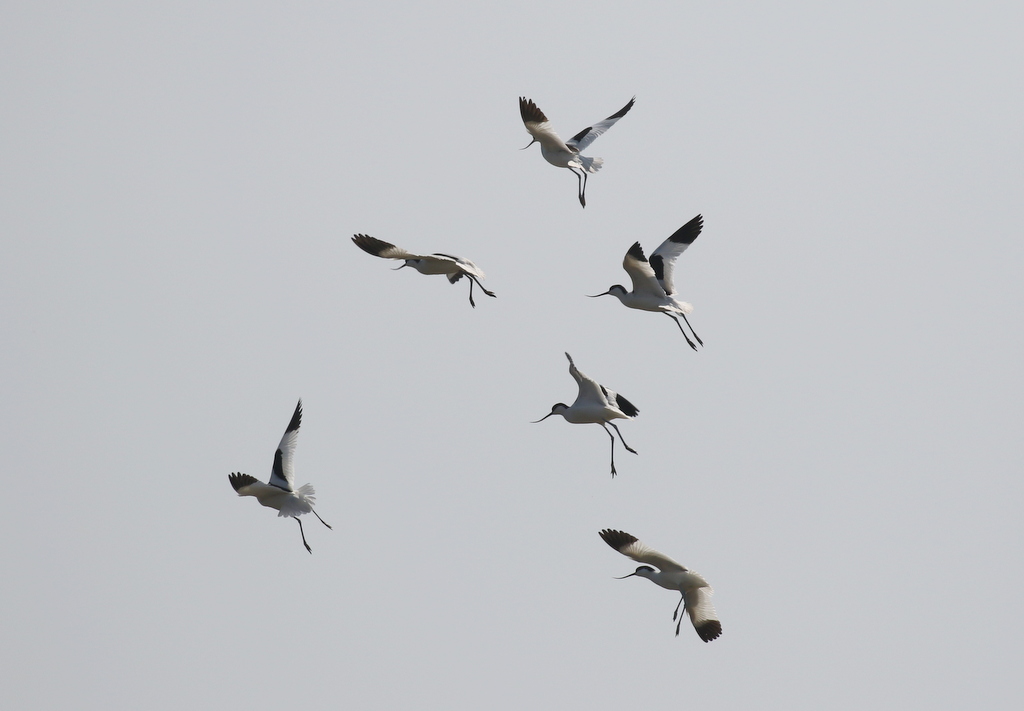
Back out on the main path, we spotted a couple of Spoonbills which flew up from the Thornham saltmarsh and headed off away from us. They landed briefly, just long enough so we could get them in the scope. We could see at least one of them was an adult with a yellow tip to its bill, bushy crest and mustard brown wash on the breast. Then they flew again and when they landed they walked straight down into a creek out of view.
A single Common Sandpiper was visible from up here, round the back edge of one of the islands. A second Little Gull appeared, and the two of them started to feed actively. One flew round in front of us, chased by a Black-headed Gull, giving us a nice size comparison. Then both settled on the muddy margin of one of the islands, and started picking their way along the shore, looking for insects.
There were lots of Common Swifts again, hawking for insects low over the reeds and backwards and forwards over the main path. While we stood scanning the Freshmarsh, they zoomed around over our heads.
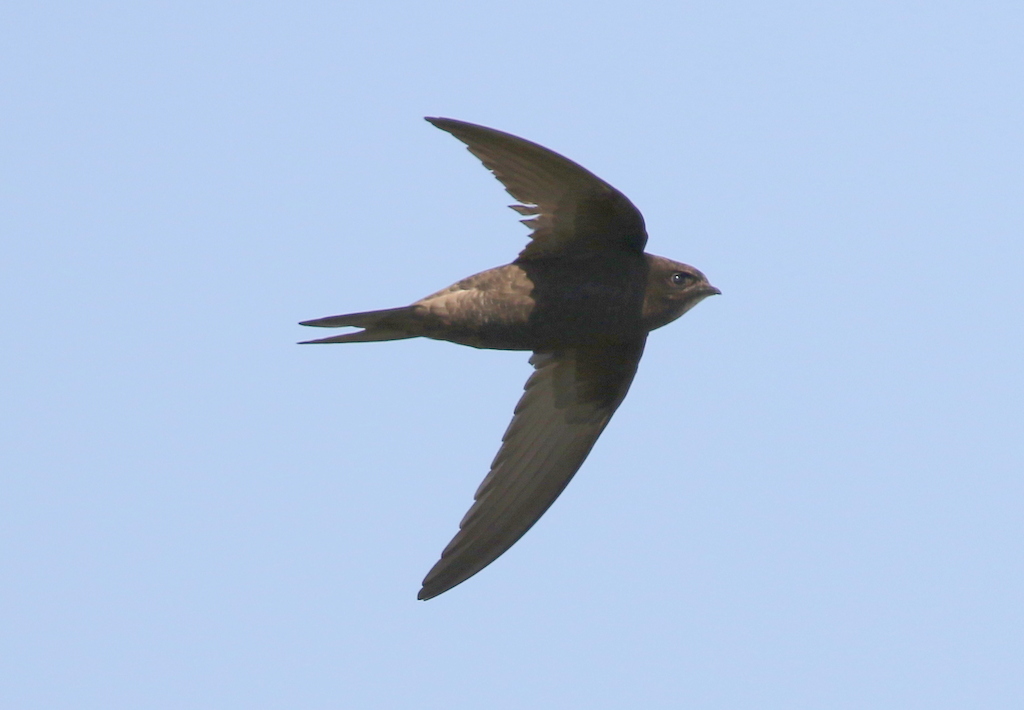
Not to be outdone, a Common Tern appeared right behind us while we were watching the Swifts. If we hadn’t turned round, we would almost have missed it! It hovered over the near edge of freshmarsh, looking for fish in the water below.

We made our way round to Parrinder Hide. It was better light on the Little Gulls from here and we had a good look at them through the scope, feeding along the edge of one of the islands. We had a closer look at the Mediterranean Gulls too, in amongst all the Black-headed Gulls in the fenced off ‘Avocet Island’ colony. It should probably be renamed ‘Gull Island’!
Three Little Ringed Plovers were visible from the hide. One was along the near edge of reeds out to the right of the hide and a pair were feeding around a little pool out to the left. A party of eight Bar-tailed Godwits dropped into the middle of the Freshmarsh, presumably coming in from the beach for a wash and brush-up, all still in non-breeding plumage. A single Turnstone dropped in with some Oystercatchers out on the edge of Tern Island too.
There are not so many ducks left out here now, since most of the winter visitors have left for the breeding season further north. We could still see the Garganey from here, but the light was not much better. There were also a few Shelduck, Gadwall and Shoveler, all of which may well breed here. Several Mallard broods of ducklings were already to be found around the edges. Otherwise, a single drake Teal was asleep on the island in front of the hide, still lingering on. Some of the Brent Geese are also still here, and flew in from the saltmarsh for a bathe and preen. They should be departing soon for Russia.
After another productive morning here on the reserve, we headed back to the car. We drove inland next, round via Choseley to look for some farmland birds. It was rather windy up on the ridge though, so we found just a few Stock Doves around the fields here at first. A couple of Mediterranean Gulls flew past us, over one of the fields beside the road.
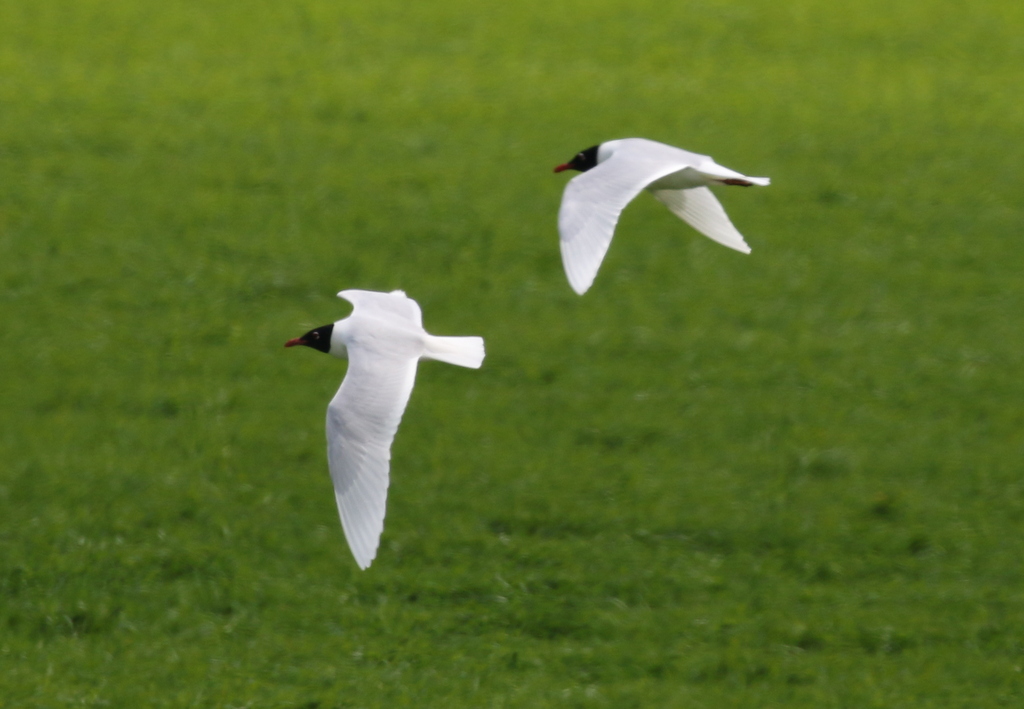
We wanted to have a look for Corn Buntings. We couldn’t find any at the first couple of places we checked, all was quiet in the wind. As we drove round via another site and passed a thick hedge we could hear a Corn Bunting singing. We parked and got out of the car, walking up along the hedge slowly, stopping to listen and scan, but we couldn’t see it. It was obviously keeping well tucked down today, and then it went quiet.
As we carried on up the road, we flushed several Yellowhammers which were feeding down on the gritty edge, out of the wind. A Brown Hare was in the middle of the road too, but thankfully had the sense to get out of the way.
News had come through of what was probably a Blyth’s Reed Warbler singing at Holkham. We were headed that way anyway, so we decided to stop and eat our lunch where it had been heard, in case we could hear anything too. As we got out of car, a male Marsh Harrier flew right round in front of us over the edge of the grazing marshes.

There was nothing singing in the bushes at first. The wardens pulled up and we listened to their recordings from earlier – it sounded like a Blyth’s Reed Warbler singing. As we ate our lunch, a few Spoonbills and Little Egrets flew back and forth over the marshes and the Drive.
After a while, the warbler started singing again. It was deep in the trees at first but hard to hear in the wind and with several cars passing behind us, only the odd whistle carried to our ears. Gradually it worked its way down to the near end of the bushes, closest to the road, and we could hear it better.
The song was a rather Reed Warbler-like series of clicks and chacks, but with regular whistles, including some pretty distinctive three-note exercises which are fairly typical of Blyth’s Reed Warbler. It was interesting to hear, but we couldn’t see it in all the leaves and thick vegetation from where we were out on the roadside. Blyth’s Reed Warblers are notorious skulkers!
After a while we decided to give up and continued up to the top of Lady Anne’s Drive, where we parked again. It was sunny now, and getting very warm in shelter of trees as we walked west. There were still a few warblers singing – Blackcaps, Chiffchaffs and a Willow Warbler. We found a few Coal Tits and Long-tailed Tits in the pines and could hear Goldcrest and Treecreeper singing too. A Jay flew across the path and disappeared into the trees.
There was nothing on Salts Hole, so we continued on. As we came around the corner, we saw something chased off the path ahead of us by one of the local Robins. A few seconds later, a female Common Redstart dropped down onto the path from the trees again. It kept flying up into the trees and back out again – flashing its red tail. Then another couple walked past us and flushed it from the path. We continued on and could see it still in the trees waiting for us to pass.
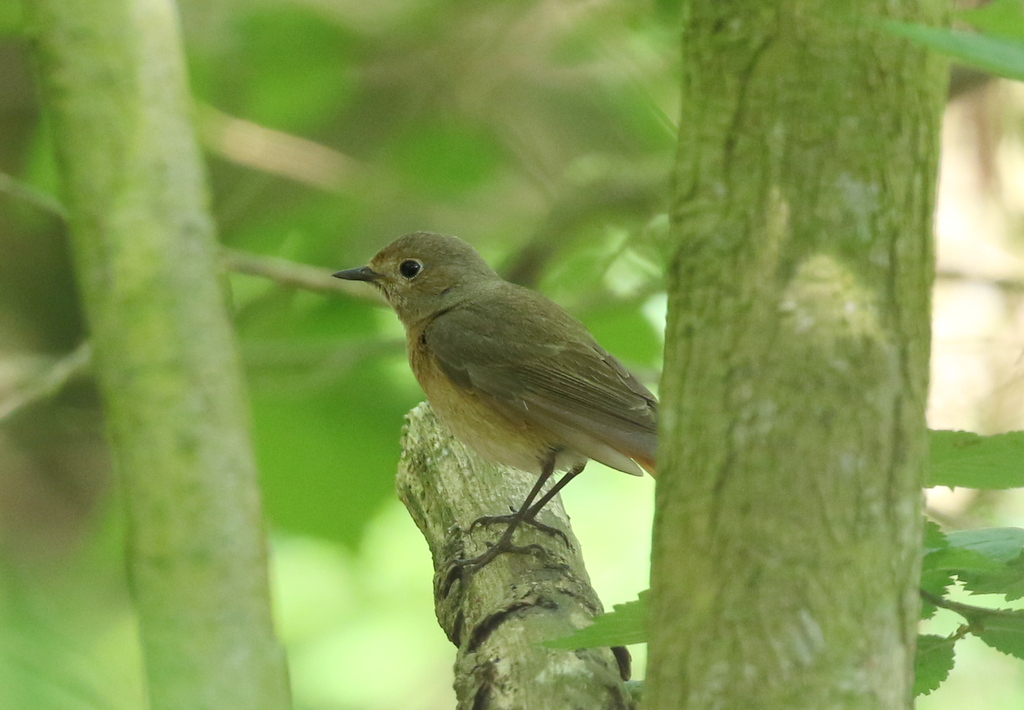
With the birds we had seen and heard this morning – Blyth’s Reed Warbler, Greenish Warbler and now a Redstart – it suggested that the easterly winds had drifted some birds over from continent. So we carried on straight out to the edge of the dunes to see if there were any more migrants out there.
There were lots of butterflies out on the walk by the pines. In particular, we saw good numbers of Wall Brown – nice to see, as they have got increasing localised in recent years. There were several Holly Blues around the trees and Red Admirals and Peacocks basking on path. There were plenty of whites too – including Green-veined and Large White.
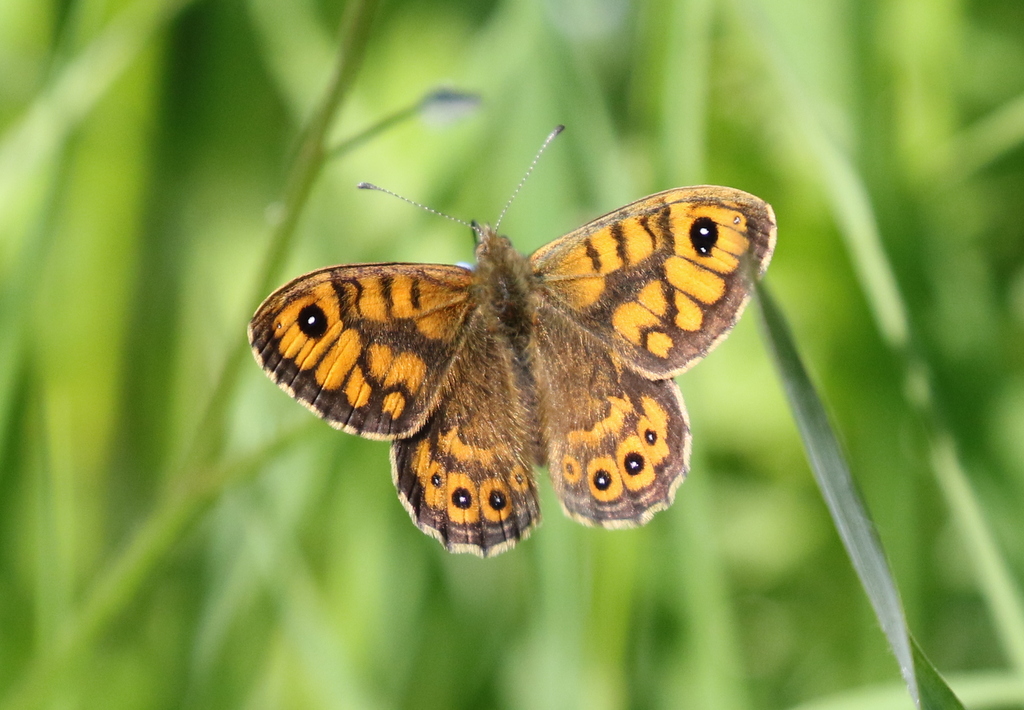
There were a few dragonflies out this afternoon too. We stopped to look at a smart male Broad-bodied Chaser basking on the bushes just before the gate at the end of the pines.
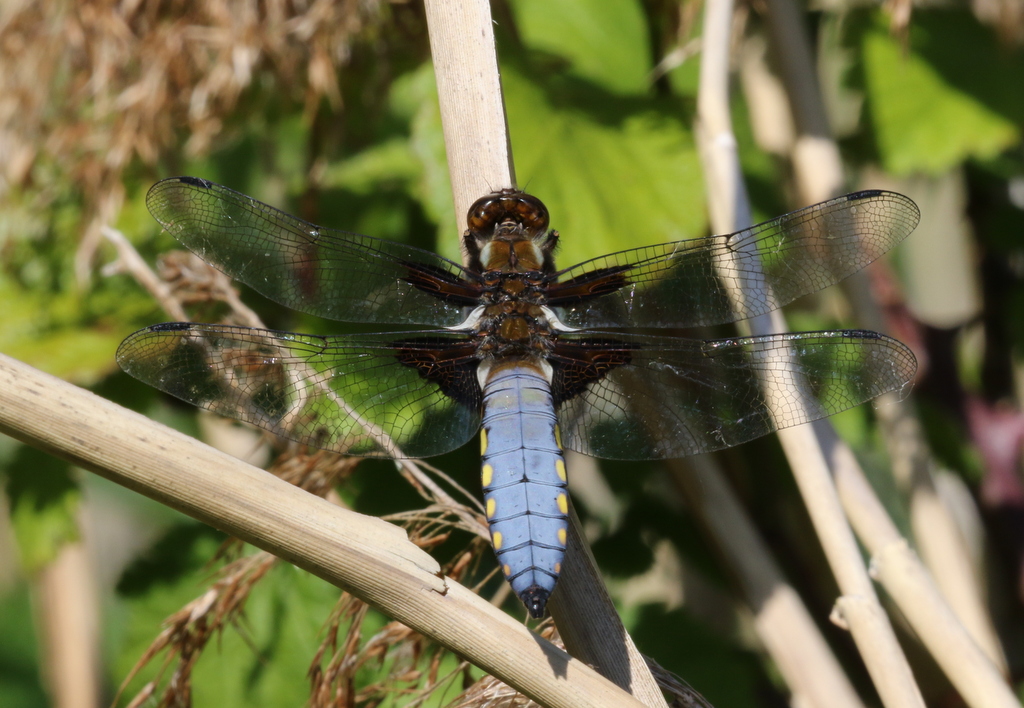
Out into the dunes, all seemed fairly quiet. It was the mid afternoon lull, so perhaps there might have been more around earlier on. A quick walk round the nearest brambles, failed to produce anything out of the ordinary. There were loads of Linnets down on the ground which flew up as we passed. A bright Cinnabar Moth fluttered up and landed back down in the grass.
Joe Jordan Hide was our last destination for the day. As we got into the hide, we could see an Egyptian Goose out just in front. There were loads of Greylags too, further out around the old Fort.
Gradually the Spoonbills appeared – flying in and out of the trees – and a couple dropped down onto the pool to bathe. Unfortunately they landed behind the tall reeds at the front, out of the wind and out of view. A Great White Egret came up out of the trees but landed back down in the reeds, also where we couldn’t see it. There were Little Egrets, one or two Grey Heron and lots of Cormorants coming and going too.

It was a nice way to end the day and the tour, sitting in the hide here. It had been an exciting few days – with lots of great birds and other wildlife. Now it was time to head back home.
















